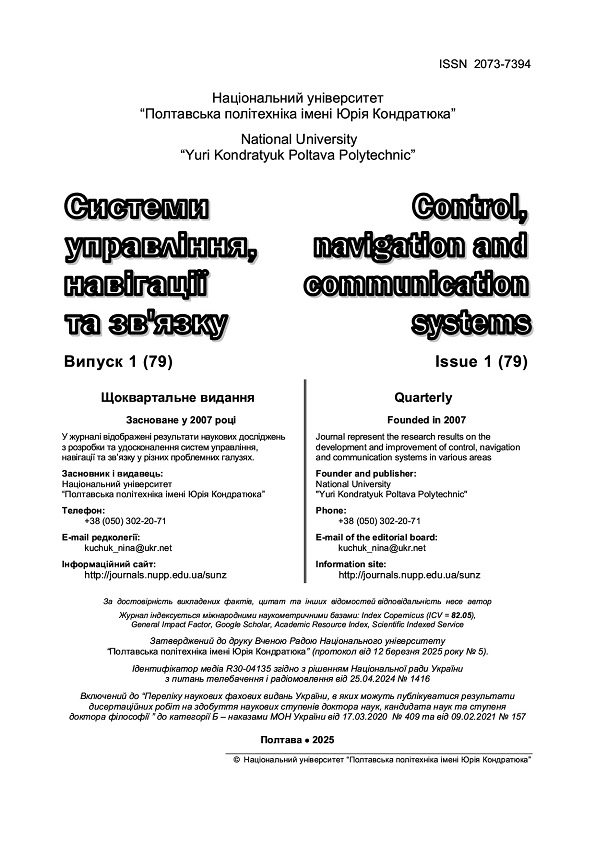On the features of triplet’s formation for Siamese neural network training
DOI:
https://doi.org/10.26906/SUNZ.2025.1.134-137Keywords:
Siamese neural network, triplet, embedding, prototype cluster embedding, neural network testingAbstract
Summary. The subject of research – image recognition processes using neural networks. The recognition
application is based on a Siamese network architecture with a triplet loss function and a convolutional neural subnetwork. The
purpose of the article – to justify the choice of a quasi-random N-dimensional sequence of vectors as embeddings for training a
Siamese neural network with a triplet loss function and to evaluate the characteristics of the clusters of digit image embeddings
obtained after training. Objective: an experimental evaluation of the characteristics of clusters of embeddings of digit images
obtained after training a Siamese neural network with a triplet loss function. Research methods: a direct search method for functions with several variables to determine estimates of N-dimensional vector representations of input images. Research results.
A study of a quasi-random N-dimensional sequence of vectors as embeddings for training a Siamese neural network with a triplet
loss function and its testing is carried out. It is shown that the proposed methods for determining N-dimensional vector representations of input images are robust and significantly reduce the amount of computation during training. During testing, images of
handwritten digits from the MNIST test set were used. It has been determined that the use of a quasi-random N-dimensional
sequence of vectors as image embeddings in training a Siamese neural network with a triplet loss function can significantly improve
the characteristics of the obtained image embedding clusters. Conclusions. The results obtained in this work can be used for comparative evaluation and determination of N-dimensional vector representations of different classes of input images for their recognition using the architecture of a Siamese neural network with a triplet loss function.
Downloads
References
1. Chicco D. Siamese Neural Networks: An Overview. Artificial Neural Networks. MIMB, vol. 2190, 2020, pp. 73-94. URL:https://link.springer.com/protocol/10.1007/978-1-0716-0826-5_3 DOI: https://doi.org/10.1007/978-1-0716-0826-5_3
2. Шостак А. В. Про особливості формування дескрипторів у сіамській нейронній мережі. Системи управління, навігації та зв'язку, Полтава: НУ ПП, 2021, вип. 4(66). С. 91-96. DOI: https://doi.org/10.26906/SUNZ.2021.4.079 DOI: https://doi.org/10.26906/SUNZ.2021.4.079
3. Шостак А. В. Про особливості формування вхідних даних у сіамській нейронній мережі. Системи управління, навігації та зв'язку, Полтава: НУ ПП, 2024, вип. 3(77). С. 193-195. DOI: 10.26906/SUNZ.2024.3.193 DOI: https://doi.org/10.26906/SUNZ.2024.3.193
4. Schroff F., Kalenichenko D., Philbin J. FaceNet: A unified embedding for face recognition and clustering. Proceedings of the IEEE CSC on CVPR, 2015, рp. 815-823. DOI: https://doi.org/10.1109/CVPR.2015.7298682
5. Craeymeersch Е. One Shot learning, Siamese networks and Triplet Loss with Keras. URL: https://medium.com/@crimy/oneshot-learning-siamese-networks-and-triplet-loss-with-keras-2885ed022352
6. Trotter С. How To Train Your Siamese Neural Network. URL: https://towardsdatascience.com/how-to-train-your-siameseneural-network-4c6da3259463
7. Owen A.B. On Dropping the First Sobol’ Point. In: Keller, A. (eds) Monte Carlo and Quasi-Monte Carlo Methods. MCQMC 2020. Springer Proc. in Mathematics & Statistics, vol 387. Springer, Cham. DOI: https://doi.org/10.1007/978-3-030-98319-2_4 DOI: https://doi.org/10.1007/978-3-030-98319-2_4
8. The Mnist database of handwritten digits. URL: http://yann.lecun.com/exdb/mnist/
9. Hernandez-Orallo J. ROC curves for regression. Pattern Recognition. 2013. vol. 46, no. 12. pp. 3395–3411. doi: DOI: https://doi.org/10.1016/j.patcog.2013.06.014
10. 1016/j.patcog.2013.06.014 10. Van der Maaten L.J.P. Accelerating t-SNE using Tree-Based Algorithms. Journal of Machine Learning Research 15(Oct). – 2014. - C. 3221-3245.
Downloads
Published
Issue
Section
License

This work is licensed under a Creative Commons Attribution-NonCommercial 4.0 International License.




